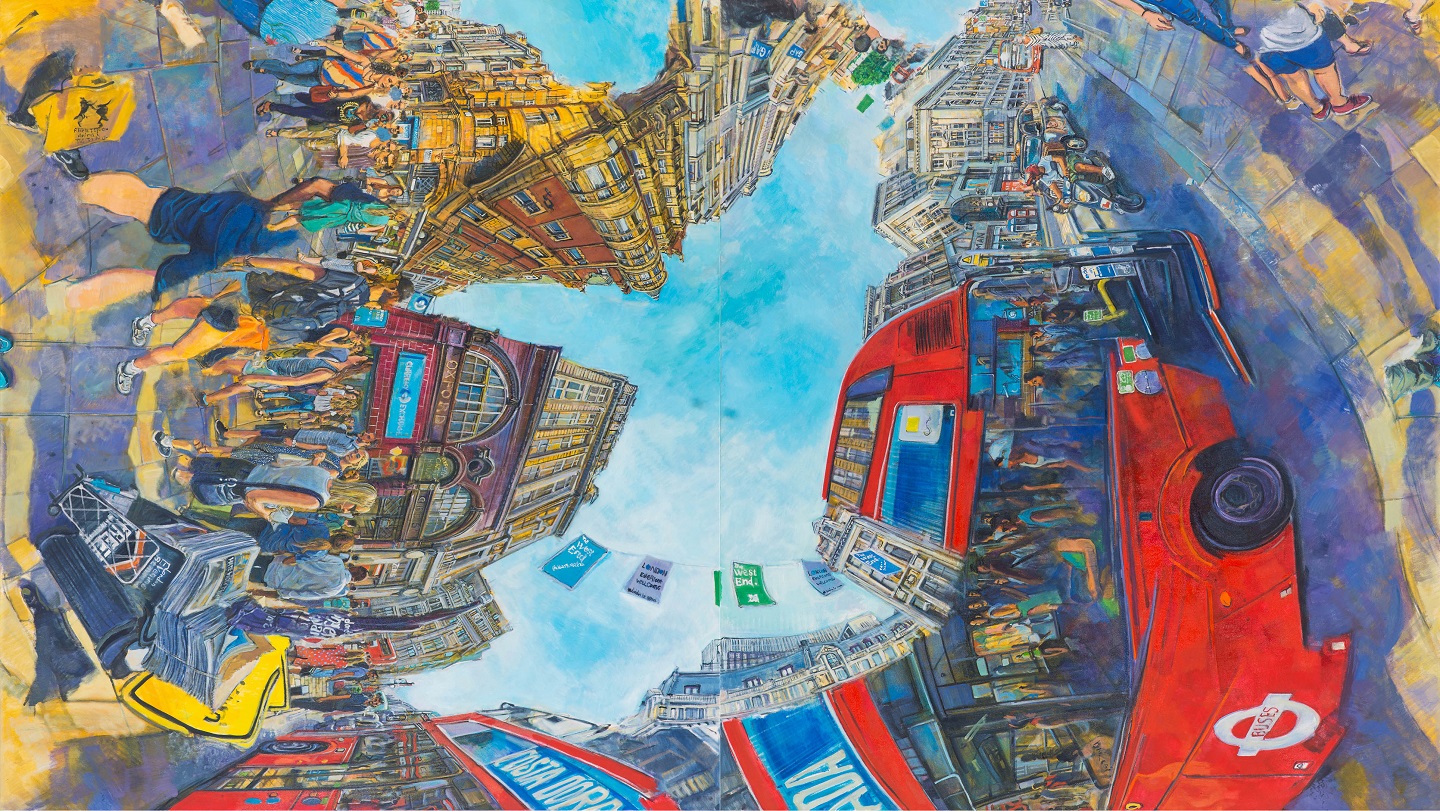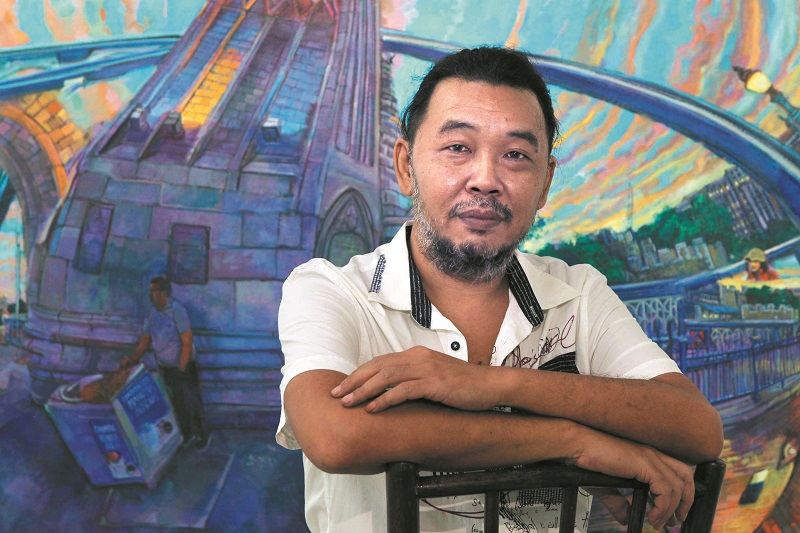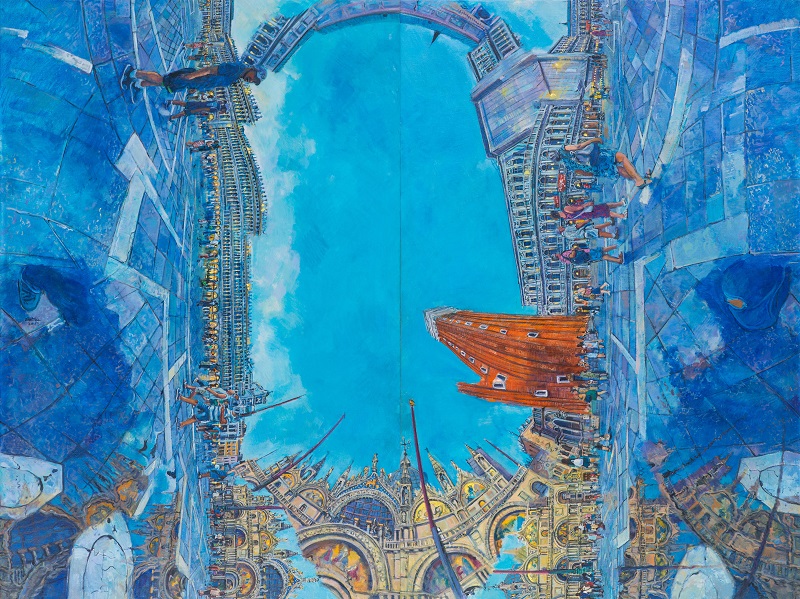
Red Buses (Photo: Chin Kong Yee)
Art challenges and changes perceptions, and no one embodies this maxim quite like Chin Kong Yee. At first glance, the “fish-eye” style of painting that has become the KL-born artist’s hallmark presents a disorienting picture. As his technique evolved over the years into a 360° rotatable and interchangeable style, the sense of intrigue and distraction has become even more marked.
Stepping in for a closer look at Chin’s works of diptychs and quadriptychs reveal, quite literally, a world of detail and no lack of vantage points — he designs his images so that he is able to create infinite connections and possibilities, if he so chooses to build on them, canvas by canvas. That said, there is a recurring question when one looks at his works, which is, “What am I supposed to see?”
In this case, we are viewing Chin’s 7th solo exhibition with Wei-Ling Gallery, Dancing with Shadows. There are five new works in total, not a lot, but they are large pieces that took him 13 painstaking months to complete.
While he painted a flower series for his last solo, he chose to depict a recent visit to Europe this time. More specifically, he painted scenes of London and Venice, the two cities he feels most strongly about.
A diptych, titled Red Buses, shows a typical London scene of a busy shopping street, albeit in a surreal composition.
“Most of us have a certain preconceived idea of London, or England. But I saw all colours of people speaking all sorts of languages. It made me think that, before, the British almost colonised the world, and now everyone is in, or comes to, London. It is very cosmopolitan, and the feeling is great. To think, just 100 years ago, that many of these people were probably killing each other,” Chin remarks.

Another significant work is Piazza San Marco, a famous public square in Italy he first visited 12 years ago. “It’s a place you can never forget. When I arrived there, all the memories came flooding back. That’s why I say I met the old Chin Kong Yee at the square, had a dialogue, and moved on,” he reflects.
The two-panel artwork, particularly when it is configured in a way that presents the square in a circular loop, feels like an apt metaphor of the idea of facing one’s past, as he describes his trip there. It also offers a hint of his enduring fixation with his surreal, distorted style that has become increasingly bold.
To state the obvious, his works invite viewers to look at things from a different angle. The challenge is to temporarily suspend the established ways with which we perceive reality. His choice of depicting well-known landmarks is deliberate, to allow the viewer to quickly see beyond the familiar memory of the image itself.
Chin observes, “Too often, we see things in a fixed way. It always has to do with our perception of things because we create our reality through our perception. Some things may be important to you, but do not matter to others. Today, without realising it, we are becoming more and more extreme. With more and more fixed perceptions, we suffer, we may become more depressed, and even push ourselves into a corner and become suicidal. Most of society’s conflicts are because of how we perceive our reality to be better than others’.”

In Dancing with Shadows, he presents his revelations of perceiving reality through the fundamentals of art itself. The artist symbolically draws parallels from artistic principles of light and shadow to life itself. “Light is the objective world, the shadow is us. But neither just the light nor the shadow creates reality. It has to be light, shadow and the dancer that forms our world as we know it. How we perceive our world depends on what interrupts light and shapes the shadow. The dancer is always invisible and everyone’s dancer is different, but it affects different outcomes, like a filter.”
Bridges feature in three other artworks — the Tower Bridge in London, and the many connecting bridges in Venice’s alleyways and canals. Chin sees them as a connector not just physically but also symbolically, as a “dancer” that influences two separate realities. Interestingly, he alludes to the significance a city’s residents often attach to a bridge, as if acknowledging its power as a symbol.
Less overtly, another perception he challenges is the concept of time. Beyond day and night and the measurement of speed, Chin sees time as a psychological idea and not a physical existence, a modern product of collective consciousness and action.

“For me, past is memory, and future is expectations. Now, the present, is perception. It’s always perception,” he emphasises. In a way, his paintings make more sense if one suspends the idea of time and chronology, creating freedom to explore what is possible. Because of that, he points out, he can logically include the same person twice in a scene at different ends. “If I remove time, I can make this a reality.”
Yet, in this surreal reality, the artist is adamant that his technique, which he dubs “actuality accorded painting” of capturing images in the present — viewers are in the moment themselves rather than observing past static images — is not within the category of surrealism.
“It is real, tangible, but it is just that I moved away from presenting it in a linear and horizontal way because people tend to ignore the horizontal or vertical line and only see what stands out. I tried to embrace the totality of what I have seen, and rather than filter it, or to take only what I wanted to take, but instead I presented it as naturally and raw as possible, only perhaps like a dream.”
'Dancing with Shadows', Wei-Ling Contemporary, 6th floor, The Gardens Mall, until Sept 2. Admission hours are 11am to 7pm (Tuesday to Sunday). For more details, call 03 2282 8323. This article first appeared on Aug 20, 2018 in The Edge Malaysia.


